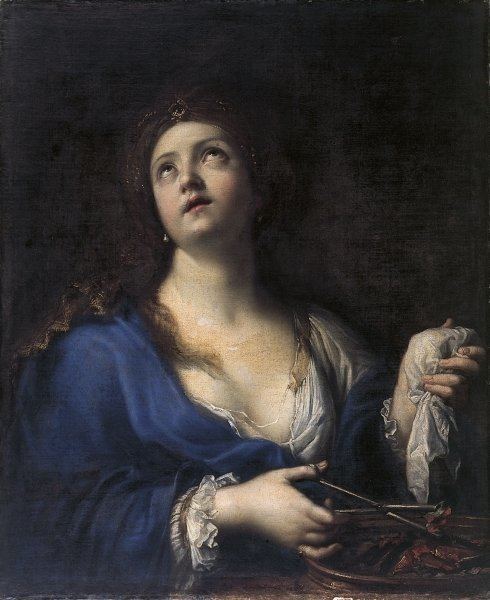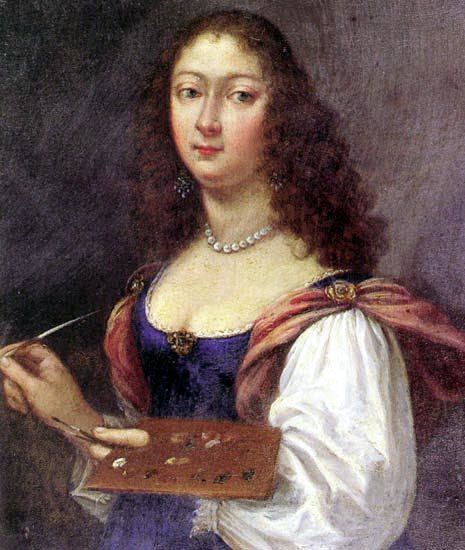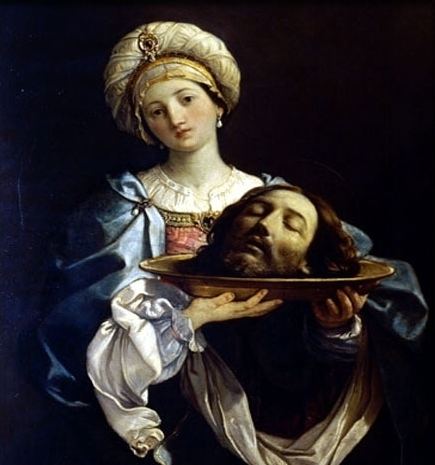Role Painter Artwork Virgin and Child Name Elisabetta Sirani Period Baroque | Movement Baroque Known for Painting Parents Giovanni Andrea Sirani | |
 | ||
People also search for Giovanni Andrea Sirani, Mary | ||
the funerary procession of elisabetta sirani biographical film
Elisabetta Sirani (8 January 1638 – 28 August 1665) was an Italian Baroque painter and printmaker who died in still unexplained circumstances at the early age of 27. She was the most famous woman artist in early modern Bologna and established an academy for other women artists.
Contents
- the funerary procession of elisabetta sirani biographical film
- Elisabetta sirani
- Life
- Marriage
- Death
- Education
- Pupils
- Works
- Judith and Holofernes Mid 17th Century
- St Anthony of Padua 1662
- Portia Wounding Her Thigh 1664
- In popular culture
- References

Elisabetta sirani
Life

Elisabetta Sirani was born in Bologna in January 1638, the first of four children of Margherita and Giovanni Andrea Sirani. Sirani, like many other female artists, was born into an artistic family and was first trained in her father’s studio. She was trained by her father, a painter of the School of Bologna, who was a pupil of Guido Reni and an art merchant. Her biography is included in Carlo Cesare Malvasia’s two-volume Felsina pittrice: vite de’pittori bolognesi, or Lives of the Bolognese Painters, first published in 1678. Malvasia was personally acquainted with the Sirani family and actually took credit for recognizing Elisabetta’s talent and persuading her father to train her as an artist, although this was likely self-aggrandizing. There is evidence that Sirani’s father was not inclined, at first, to teach his daughter the way of Bolognese painting. She picked up his technique nonetheless and became one of the most renown painters in Bologna, as a cult grew around her as the female reincarnation for Guido Reni. According to some scholars, she overshadowed both her father and two sisters, who were also painters. In short, Sirani became a legend in her short lifetime. Throughout his biography of Sirani, Malvasia praises the originality of her compositions, her style of drawing, her fast manner of working, and her professionalism, contrasting her with Lavinia Fontana, an earlier Bolognese woman painter whom he describes as timid.

Giovanni Andrea Sirani became incapacitated by gout later in his career and Elisabetta began running her family's workshop by 1654. Elisabetta Sirani was at this point the primary breadwinner for the family. Between her student fees and portrait commissions, she was able to be the sole supporter of her family. Her studio was incredibly successful, likely due to the progressive atmosphere of Bologna, where women artists were more welcome and celebrated.
Marriage

Elisabetta Sirani never married, despite her personality being warm-hearted and lively temper, gracious and winning manner. Some believed, such as Malvasia, that her father prevented his daughter from marrying, however this theory may be biased. Many Italian family during the seventeenth century decide to marry their daughters to preserve their reputation or provide for their protection. The Sirani household had no intention of such and determined that Elisabetta could help with providing for the family.
Death

Elisabetta Sirani’s death brought many conspiracies to light. She died suddenly in August 1665, in Bologna. Her death was considered suspicious and a maidservant, Lucia Tolomelli, was charged with poisoning the artist and put on trial, It was deemed suspicious because Tolomelli had requested to end her service of the family only days before Sirani’s death. Giovanni Andrea Sirani withdrew the charges soon after the trial. Laura Ragg comments that Sirani died at “an age regarded as young indeed for death, but hopelessly late for marriage.” Malvasia attributed her death to love-sickness because Sirani never married. Her actual cause of death was most likely the onset of peritonitis after a ruptured peptic ulcer. This may have been the result of the intense stress she was submitted to after she was charged with providing for her entire household.
Sirani was given an elaborate funeral which included an enormous catafalque with a life-sized sculpture of the artist (illustrated in Malvasia's biography), orations and music composed in her honor by Bologna's most prominent citizens, and she was buried in the Basilica of San Domenico, Bologna, in the same tomb as her father's teacher, Guido Reni. Sirani’s public funeral is regarded as some, including Laura Ragg, esteemed American author, as a eulogy to Bologna, the city that gave birth to Sirani, considered a precocious and prolific artist by her contemporaries. Sirani was described by a poet as the “Lamented Paintbrush. Malvasia suggests that it was not poisoning but a condition that arose spontaneously in the body of a “vivacious and spirited woman, concealing to the highest degree her craving for a perhaps coveted husband denied to her by her father.” A city official at the time wrote that “She is mourned by all. The ladies especially whose portraits she flattered, cannot hold their peace about it. Indeed it is a great misfortune to lose such great artist in so strange a manner.” The ostentatious and elaborate funeral she received reflects the high esteem she was held in by her contemporaries and indeed her international fame.
Education
Elisabetta Sirani received her professional training from her father, Giovanni Andrea Sirani. Giovanni Andrea was amongst the favorite pupils of Guido Reni, one of the pronounced artists of Bologna. Elisabetta’s father did not produce many works during his lifetime, instead, he took over Reni’s job as a teacher, and became the master in the first life school held in the House of Ettore Ghislieri. However, Giovanni Andrea was repelled to take her in as pupil originally, due to his concern of her talent eclipsing his.
To prepare for her career, Elisabetta Sirani received education regarding popular subject matter during the time besides professional training. She was taught the outlines of Bible History, stories of Greece and Rome, a smattering of Heathen mythology, and legends of saints. Elisabetta was also knowledgable in the field of music, one of the reason being her brother-in-law was a musician. Although music was considered “the most detrimental to the modesty fitting to the sex, distracting them from their proper activity and occupation”, her and her family reputation was never hurt by her interests in music.
Elisabetta Sirani drew from a number of painters including Annibale Carracci, Lorenzo Pasinelli, Desubleo, Simone Cantarini, and Cignani. Malvasia, who considered Sirani his creature, presented her as the epitome of Bolognese genius in his Felsina Pittrice.
Pupils
Not only was Elisabetta Sirani the successor of her father’s workshop, she was also a great teacher of many, especially contributing to women artists’ development during the Renaissance period. She trained a number of men and women artists, including her younger sisters Barbara and Anna Maria and at least 12 other young women at a school she set up train artists.
Some of her pupils include Veronica Fontana, later known throughout Italy as a first-rate wood-engraver; Caterina Pepoli and Maria Elena Panzacchi, who also had an art career in Bologna. Camelia Lanteri and Lucretia Forni, who specialized in large-scale religious paintings. Veronica Franchi, whose predilection was for mythological subjects. Lucrezia Scarfaglia was another pupil. Lastly, there was Ginevra Cantofoli, represented during her career as Sirani’s enemy and rival.
She founded the first school of painting for women outside a convent in Europe, and made sure that it was inclusive to women, regardless of if they were daughters of painters or would otherwise have lessons made available.
Sirani received her first commission in her teens, a Baptism of Christ, a companion piece to an earlier done painting by her father at the Campo Santo of Bologna.
Works
Elisabetta Sirani produced over 200 paintings, 15 etchings, and hundreds of drawings, making her an extremely prolific artist, especially considering her early death. Of these hundreds of drawings, about a quarter of these relate to known paints or prints done by Sirani. Sirani kept a meticulous list and records of her paintings and who commissioned them beginning in 1655, which is recorded in Malvasia’s biography and many of her paintings are signed. By Sirani signing her paintings when her male counterparts did not, this could be because she did not want her work to be confused with work of her father, her signature also offered a way to further prove her powers of invention, which, according to Vasari, distinguished her from other Italian women artists. Sirani's exceptionally productivity was the product of how quickly she painted. She painted so many works that many doubted that she painted them all herself. To refute such charges she invited her accusers on May 13, 1664 to watch her paint a portrait in one sitting.
Her works cover a number of subjects, including historical and Biblical narratives, often featuring women, allegories, and portraits. Sirani was also the first female artist to specialize in history painting, a style that many other female painters that Sirani trained also followed. Sirani’s specialization in history painting is very different than other female painters of the time, who usually only painted still lives. 1657 was when she receive her first major public commission in Bologna, from Daniele Granchi, prior of the Carthusian church of Certosa di Bologna.
She painted at least 13 public altarpieces, including The Baptism of Christ at the Certosa di Bologna of 1658. Around 1660, she began focusing extensively on small-scale devotional images, particularly Virgin and Child and Holy Family, which were enormously popular with private collectors. Her patrons ranged from cardinals to kings, princes, dukes, merchants, and academics from Bologna and across Europe. Sirani became a celebrity in her city as visitors, such as diplomats, political leaders, and noblemen, would come to her studio to watch her work.
Sirani’s style is close to that of her father’s teacher, Guido Reni, but Elisabetta employed more dramatic contrasts of light and shade, virtuoso brushstrokes, and more brilliant color. More similarities of her works may be found in the draftsmanship of Ludovico Carracci, Giovanni Francesco Barbieri (Guercino), and Simone Cantarini (Bohn). Her striking images of female heroines, such as Portia Wounding Her Thigh are comparable to the work of Artemisia Gentileschi. Sirani often selected lesser-known subjects for her paintings and her unique interpretation of iconography drew praise from a number of contemporaries. “Sirani made drawings in a variety of media, such as brush and wash, pen and ink with wash, black chalk, red chalk, and a combination of the two.” Her drawings, while done in many different media, usually in pen or brush and ink, display the same brilliance as her paintings, often quickly executed with what Malvasia describes as "nonchalance."
Sirani managed to thwart visual gender conventions, whereby portraiture was the expected genre for female artists. Instead, she transformed the format into an allegorical mode that solicits the observer's interpretation of the work. Sirani based many of her allegories on Cesare Ripa's descriptions from his Iconologia, published in 1611. Some of her favored topics included Greek and Roman mythology and mythological figures, and the poetry of Horace.
Male nudity was not often attempted by female artists of the time as they did not wish to display their lack of experience from life-drawing (a practice which was typically withheld from them). They were aware of the prurient effect inclusion of such subject matter may have on their reputations. If the male nude was depicted, it was usually done in a religious tone, depicting Jesus Christ for example. Ten Thousand Crucified Martyrs' composition is replete with male nude figures. While it does fall under this religious category of the male nude, Sirani’s work displays a strong sense of individuality.
Judith and Holofernes, Mid-17th Century
The subject of Judith is a popular one for female artists of the seventeenth century, and even before and after. The number of women completing and studying history paintings increased at this time. This was especially prevalent for those who had fathers who exclusively studied history painting, or mostly this topic. Elisabetta Sirani was no exception, as her father, Giovanni Andrea Sirani, studied and taught history painting. In Sirani’s rendition, extremely different from Gentileschi’s Caravaggio-esque version, Judith is the apex figure, creating a classical, triangular composition reminiscent of the Renaissance. Judith’s handmaiden is old and decrepit, aiding Judith with carrying the head of Holofernes. Sirani portrays Judith in the nighttime, succumbing to the viewer with her act of murder. This painting has often been compared to Gentileschi’s Judith Slaying Holofernes from 1620, which has often been regarded as violent. Both represent Judith as a strong figure, though Sirani’s hierarchically reaches the top of the picture plane. Whereas Gentileschi conveys the handmaiden in total collusion with Judith and a very large piece of the puzzle, Sirani portrays a less active handmaiden, emphasizing the forcefulness of Judith in this way.
In other renditions of Judith and Holofernes by Sirani, Judith is still cool and mild-mannered. Her fierceness lies in the action of slaying Holofernes, rather than in her face or movements within the composition. In each of Sirani’s versions, Judith does not look at the decapitated head of Holofernes. Rather than being decisive and involved, as Gentileschi’s Judiths are, she is rather a beautiful woman to be regarded and appraised. This fact and comparison to Gentileschi proves that the underlying female-ness of the paintings have nothing in common other than the fact that they were both created by females. Feminist art historians have argued this in an attempt to prove that female artists can stand on their own.
St. Anthony of Padua, 1662
This painting is hung in the Pinacoteca in Bologna near the work of Guido Reni. The young saint, who is normally portrayed as an ascetic dreamer, is seen here kneeling as a lover of children. The celestial children are painted with an essence of earthly delight that some scholars regard as never been done before. The composition reveals a diagonal thrust that contrasts greatly with the other paintings in the same gallery. It was commissioned by Giovanni Battista Cremonese, a jeweler.
Portia Wounding Her Thigh, 1664
This painting is often understood from a feminine perspective. The image consists of a somber background and a large Portia clad in red wielding a knife above her already bleeding, exposed thigh. Many feminist scholars regard this as an image of a strong-willed woman. According to Plutarch, the original teller of the story of Portia wounding her thigh, Portia harmed herself greatly to prove to her husband, Brutus, that she could share in his burdens and secrets. The idea was to convince her husband of her strength of will. However, modern scholars reflect how this image may not be as feminist in its message as others have interpreted. Modern scholars argue that the necessity of self-mutilation to prove a woman’s strength of will in order to have access to her husband’s thoughts questions such a feminist reading. Furthermore, a sadomasochistic sexuality is latent in Portia’s exposed thigh, loosened robe, poised knife, and her snake-like headdress. The seventeenth century was rife with dark, sexual, violent, and disturbing images, so it is not surprising that Sirani chose a heavy, closed atmosphere with somber lighting and rich colours. This mode of representation reflects her teacher, Guido Reni, as opposed to Artemisia Gentileschi, whose work is often held up against Sirani’s. In this painting, Sirani confirms Reni’s overarching sexual ideology, while Gentileschi’s work often disrupted this.
In popular culture
Sirani is referenced in Judy Chicago's The Dinner Party
In 1994, a crater on the planet Venus was named after Sirani.
Sirani's painting Virgin and Child of 1663, now in the collection of the National Museum of Women in the Arts in Washington, DC, was selected for the United States Postal Service Christmas Holiday Stamp series in October 1994. This was the first work by a woman artist chosen for the series.
Her Herodias with the Head of John the Baptist is featured on the cover of the Canadian technical death metal band Cryptopsy's 1996 album None So Vile.
